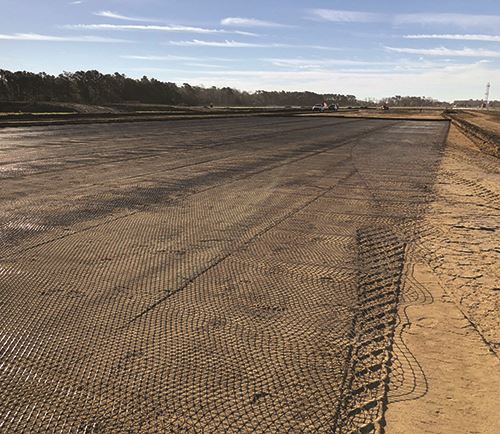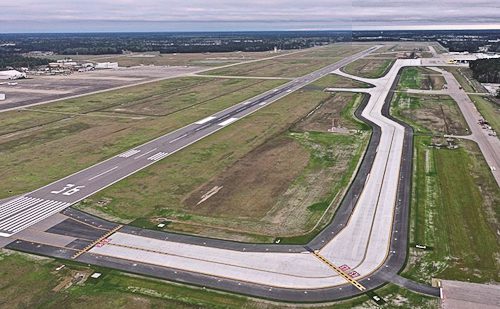Myrtle Beach International Airport (MYR) got three wins from one project when it completed a $60 million taxiway reconstruction in 2021. Taxiway A, which ran parallel to MYR’s sole runway and served its commercial terminal, was one of the few remaining vestiges of a former military base.
Myrtle Beach International Airport (MYR) got three wins from one project when it completed a $60 million taxiway reconstruction in 2021.
Taxiway A, which ran parallel to MYR’s sole runway and served its commercial terminal, was one of the few remaining vestiges of a former military base. Translation: It was old, and the asphalt pavement had shoving, rutting, cracking and spalling. Maintenance was seemingly always in process, sometimes completely closing portions of the key taxiway to traffic.
Knowing something had to be done, MYR officials opted to build an entirely new taxiway. While reviewing airport planning documents, they realized project engineers could push the taxiway closer to the runway.
|
Project: New Taxiway Location: Myrtle Beach (SC) Int’l Ancillary Work: LED taxiway lights & signage; new apron; new airside service road; new electrical vault & associated cabling Total Cost: $60 million Funding: FAA grants ($52 million; airport $8 million) Construction: 1st quarter 2019-3rd quarter 2021 Consultant: Delta Airport Consultants Concrete Contractor: Summers Concrete Contracting Geotechnical Engineer: S&ME Electrical Engineer: Ohmega Electrical Vault Mfg: Smith-Columbia Taxiway Edge Lights: Crouse-Hinds LED Signage: Lumacurve Pavement Markings: HASCO Of Note: New taxiway is located closer to runway, freeing space for new vehicle service road & future terminal expansion |
In the end, the nation’s second busiest single-runway airport got the new taxiway it sorely needed, and also netted two other valuable improvements: an airside service road (also sorely needed) and space for future terminal expansion where the old taxiway used to be.
Breck Dunne, director of airport development at MYR, notes that the new taxiway has 30- to 40-year pavement life to serve commercial carriers and other traffic. “Construction provided numerous jobs to the community, and the new taxiway will help us generate more air traffic and bring more commerce to the airport,” he adds.
Dire Straits
The project was a long time coming, with airport personnel carefully monitoring the pavement deterioration year after year. “We were seeing severe rutting and shoving,” Dunne recalls. “With the old pavement and extreme summer heat, the asphalt would get soft. And with increased air traffic and larger aircraft, we were seeing even more rutting and shoving.”
A few times, the airport was forced to close sections of the taxiway for last-minute emergency repairs. When that occurred, aircraft had to use alternate taxi routes to navigate around the closed sections.
When planning for improvements began, the airport had numerous meetings with the FAA to discuss materials (asphalt or concrete), scheduling demands and the overall impact a reconstruction project would have on operations. “During that time, we came to the realization that concrete was probably going to be our best option,” says Dunne.
FAA provided $52 million for the taxiway reconstruction through four different grants. MYR contributed about $8 million in cash and funds from other sources. Due to the cost and availability of FAA funds, work was divided into two separate bid packages. Construction began in first quarter 2019, and the new taxiway opened for service in third quarter 2021.
Seizing Opportunities
During design discussions, the project team opted to move the taxiway closer to the runway from its previous separation of 1,040 feet to 600 feet, with bump outs of 725 feet at each runway end to account for the glide slope critical areas. This allowed engineers to turn the former taxiway into an airside service road, and it opened up space for a planned terminal expansion.
The new taxiway was designed to Group 5 standards: 75 feet wide with 30-foot wide paved shoulders. It runs the entire length of the runway—9,500 feet. The project also included all connectors, including two high-speed exit taxiways and an apron expansion.
The first phase of construction concentrated on the south end of the taxiway; the second phase, on the north end. The pavement was created with a 6-inch crushed aggregate base course, followed by 6 inches of cement treated base and topped with 16 inches of P-501 concrete.
Shallow Groundwater
 Given the airport’s low elevation and proximity to the Atlantic Coast, contractors faced issues associated with perched (unconfined) groundwater. “The high groundwater forced us to install an extensive pavement edge drain system along the edge of the concrete to get water out from under the pavement itself,” Dunne explains.
Given the airport’s low elevation and proximity to the Atlantic Coast, contractors faced issues associated with perched (unconfined) groundwater. “The high groundwater forced us to install an extensive pavement edge drain system along the edge of the concrete to get water out from under the pavement itself,” Dunne explains.
More than 33,000 linear feet of PVC edge drain/underdrain was installed to help remedy the situation.
 Project Manager Doug Sander, of Delta Airport Consultants Inc., says one of the biggest challenges was grappling with the soil conditions. “They were very low quality and required us to do quite a bit of undercut and backfill,” he relates. “They were soft, not good for compaction and could not support the weight above them.”
Project Manager Doug Sander, of Delta Airport Consultants Inc., says one of the biggest challenges was grappling with the soil conditions. “They were very low quality and required us to do quite a bit of undercut and backfill,” he relates. “They were soft, not good for compaction and could not support the weight above them.”
Engineers specified geogrid fabric under the new soil to increase stabilization. Fortunately, the soil issues were not a surprise. Preconstruction subsurface borings revealed the issues, and the project team budgeted additional time and expense to address them.
Nighttime Routine
Construction required a tight schedule and night work on a regular basis. Overall, the airport’s sole runway was closed from midnight to 6 a.m. for nearly a year (320 days).
“Every taxiway connector tied to the runway required nightly runway shutdowns,” says Dunne. “During that time, the contractor needed to coordinate with our Ops folks and the airline folks to close the runway to get out and excavate and pave and then safe-up the runway environment before the next landing or takeoff took place.”
The steady stream of night closures presented challenges for Summers Concrete Contracting. “It took a team effort from our crew, from Delta Airport Consultants and the airport to make sure everything was good to open the runway up again each morning,” recalls Brad Mullis, a company vice president and project manager for the MYR taxiway reconstruction.
 “Planning was the biggest thing,” says Mullis. “Our first morning didn’t run over, so that told us we had a good plan in place. It was multiple-step construction, where moving material every night and putting it back every morning was the name of the game. The challenge was always ensuring everything was back in place by 6 a.m. so the airfield was safe for planes to land.”
“Planning was the biggest thing,” says Mullis. “Our first morning didn’t run over, so that told us we had a good plan in place. It was multiple-step construction, where moving material every night and putting it back every morning was the name of the game. The challenge was always ensuring everything was back in place by 6 a.m. so the airfield was safe for planes to land.”
Summers installed two concrete plants on site to accelerate work and ensure material supply throughout the project even if one plant had to shut down.
Side Benefits
Converting the former taxiway into an airside service road provided infrastructure MYR sorely needed. Previously, there was no room for a service road, so sometimes airport vehicles had to drive on the taxiway. “This is a huge increase in safety,” says Sander.
The airport also gained valuable space for a terminal expansion project that is currently in the design phase. Since contractors were already pouring concrete for the taxiway reconstruction, airport officials decided to add a new apron in the area earmarked for terminal growth. About 20,300 square yards of concrete was poured to create the new apron, which connects to the new taxiway. Currently, the airport is using the new apron for hardstand overnight parking and irregular operations.
Dunne notes that gate schedules were revised during apron construction, but no airlines were displaced because the airport has common-use gates. “We did have to move the taxi lane and a non-movement line as well for a short time,” notes Sander.

A new airfield electrical vault was designed and installed to replace the airport’s old vault, which remained from the airfield’s military days. “It was very old, small and in need of significant repairs,” says Sander. “The new precast vault provides adequate room for the airport’s existing and future needs including a new emergency generator adjacent to the new vault.”
Other related elements include new fiber optic runs to the air traffic control tower and new home runs from the vault to all the airfield systems, including new LED edge lights and airfield guidance signage.
Looking back on the project as a whole, Dunne emphasizes the value of a contractor information workshop the airport held early in the design process. “We needed that contractor feedback prior to advertising this project, and to get contractor buy-in on actual constructability,” he explains.
Speaking from the concrete contractor’s perspective, Mullis says good attitudes from all team members is what made the project work so well. “There was no ‘us versus them’ at all,” he recalls. “Some construction projects have adversarial relationships, and that’s not in the best interest of anyone. This was a real team effort. And, Myrtle Beach is one of the best-run airports we’ve worked at. It was a very successful job, and a lot of people deserve a lot of credit for it.”




